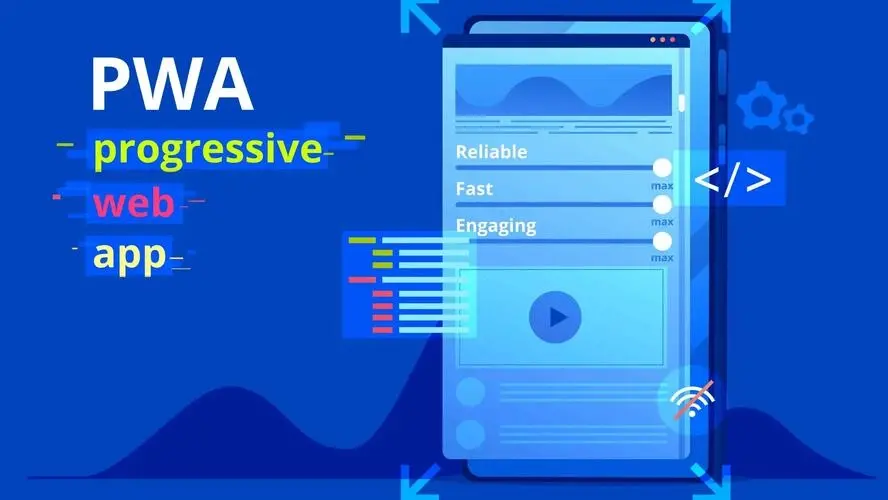According to a 2021 survey by Statista, there were over 15 billion mobile devices operating on the internet, surpassing the previous year's record of 14 billion. It's fascinating to consider that over a billion devices are connected to the internet. On a daily basis, people use various web applications, and they have proven to be excellent solutions in terms of effectiveness and performance.
Web applications of various types are required for a variety of activities, whether for business or personal reasons. Databases and messaging applications are examples of such web applications.
When creating an application, you must first decide what type you want to create. It could be a Native app, a Hybrid app, a Web app, or a Progressive Web App. In this article, we'll go over an in-depth overview of the application software known as "Progressive Web Application" to understand what it's all about.
What is a Progressive Web Application?
A progressive web application is a type of software application built using internet-based technologies like HTML, CSS, JavaScript, and JavaScript Frameworks.
It is similar to a web application that functions or opens up on your browser; however, the difference is that the Progressive Web App uses modern browser APIs and capabilities, which makes it behave like a desktop or native web application, which is simply an application built for specific operating systems.
This type of software application is referred to as "new technology" because it was introduced in 2015. Allex Russell coined the term "progressive web application" to express the ability of apps to take advantage of modern browser features, enabling users to upgrade the functionality of web applications.
Prior to the establishment of progressive web apps, we can say that there was a disparity between responsive websites and native apps.
There are many costs involved in developing native apps. For example; you'll have to build the app for different operating systems if you want to reach different devices, as we all know there is IOS, Android technology etc. Another disadvantage of Native apps is that they are not easily discovered; in other words, they are not indexed by a search engine.
In the case of Responsive websites, they are great for companies that want to build cheap and fast sites; however, there’s also the issue of limited experience. Progressive Web applications can be termed “man in the middle” because they take the technologies of a Native app and the classic responsive website and combine them to create a very progressive experience, as the name implies.
Capabilities of a Progressive Web application
PWAs are intended to provide a high-quality, engaging user experience while still providing the convenience and accessibility of a native mobile app. A web application is termed progressive if it’s able to perform the following;
Work-Offline
A progressive Web APP Must have the ability to Work Offline when there’s no internet connectivity.Instant Load
Should be able to Load instantly irrespective of the internet or network speed.Auto Self-Updates
Auto-Updating must be possible so that when the server is down it should be able to update itself when it’s back up and running.App Launch
The launch Option must be available; you should be able to load the app conveniently by clicking on the app Icon.Push Notifications
A PWA must be able to receive Push notifications from the back-end server.App Window
The app should be able to run in its own app window as well as a browser window.
PWAs can be easily deployed and updated because they are built with web technologies, eliminating the need for users to download and install updates from an app store.
Advantages and Disadvantages of Progressive Web Application
Here are some benefits and few potential disadvantages to using Progressive Web Applications (PWAs) and they include:
Advantages
Disadvantages
Advantages of Progressive Web Application
On the whole; PWAs offer a variety of advantages, including improved performance, cross-platform compatibility, easy deployment and updates, increased discoverability, and lower development and maintenance costs.
Disadvantages of Progressive Web Applications
For the most part, while PWAs have many benefits and can provide a high-quality user experience, there are a few potential drawbacks to consider when deciding whether to use a PWA for your application.
What is required to build a PWA?
To function properly, Progressive Web Applications (PWAs) rely on a few key technologies and concepts:
Service Workers
Service workers are pivotal in PWA, It’s a JavaScript code that is set up to run behind the scenes when the app is not in use. Service workers manage Cache, offline capabilities, notification support, performance, etc. In your application, you must register and configure a service worker.
Manifest
This file tells the app how to behave when installed and launched. It's a JSON file that defines your PWA's properties and behavior. It contains basic information like the app name, icons, and splash feel, giving it a native app-like behavior and experience.
HTTPS
You must serve your application over an HTTPS connection in order to guarantee the confidentiality and integrity of your PWA. This is because PWA runs in the web browser. An SSL certificate can be used to accomplish this, as it is required in the backend to provide an extra layer of security that is necessary for securing the user's data on your site. HTTPS is also necessary for service workers to function.
Web Server
The PWA needs to be hosted on a web server in order for users to access it. You can either set up your own server or use a cloud hosting service.
Tools and Frameworks for Building a PWA

There are numerous tools available to help build progressive Web apps more efficiently. To mention a few:
Workbox
A collection of libraries and Node modules to help you build PWAs very quickly. It generates service worker codes that make it easy to cache assets and detect file changes etc.
Chrome Lighthouse
This is a tool from Google that is useful to determine if your application is installable as a PWA. It’s available in the dev tool; it analyzes speed, accessibility, SEO health, etc. For instance, when you run a performance audit using the Lighthouse tools, it gives you information about what you’re doing wrong and tells you how to fix it to make your app better. The application is used to analyze and debug information related to your app.
React
React has the command create-react-app, which is a command-line script that creates a service worker and generates your web app manifest to give you a cache strategy for serving your assets.
Preact
Preact-CLI is an app development framework based on Javascript. Its features include app creation, browser list auto-prefixing, Firebase configuration for server push, etc. It’s an efficient tool for building user interfaces and is also beginner friendly.
Polymer
Polymer-CLI offers manifest generation and service workers, which are optional. The command line interface includes a build pipeline, boilerplate generator for apps, development server, test runner, etc.
VueJS
Vue-CLI is a good choice for building PWAs. Its features include app creation, manifests, service workers, app generation, etc. Its structure and code are simple, which makes it a great choice for beginners.
Svelte
Svelte is a modern, lightweight, and easy-to-use framework based on JavaScript for building user interfaces. It has built-in PWAS functionality, and Its benefits include the generation of small code bundles that are easy to install and download and a lightweight application that loads very fast.
There are more than a couple of tools that are available for building PWA, and every tool comes with different features. Depending on the type of platform you desire, you must first understand what is required and also decide the kind of behavior you want for your application. If you decide that you want to build a PWA, or have a website that you would like to convert to a Progressive Web Application, you must have the technical knowledge; otherwise, it’s best to refer to agencies with the capacity and experience to build a platform based on this technology.
Conclusion
Before the introduction of PWA, websites could only function on web browsers. Native applications were solely created to function on different operating systems, meaning they have the capability of working outside of a web browser, in their own personal window.
This new technology, PWA (Progressive Web Application), makes it efficient for users to interact with web applications in a dynamic way, It combines the qualities of responsive websites and native apps, and it’s used by most of the famous companies we know, e.g. Instagram, Facebook, Telegram, Adidas, Twitter, Pinterest, Tinder, etc. One of its advantages is its ability to provide visibility and notifications when the web application is closed.
Another intriguing aspect is that you can install a PWA on your smartphone without having to download it from any app distribution center because it is based on a single code base that can be used on any platform, including iOS, Android, and desktop. PWAs are easier to create than native apps, which require you to build the app for each operating system. This makes it a good choice for web applications, especially if you want a quick and cheap website. Do you want to know what else is fascinating? You can't tell the difference between a PWA and a native app right away, especially if you're not into the details, which is fantastic!
In terms of replacing native apps or responsive websites, I believe PWAs will not be able to do so in the near future because the technology is still in its early stages. Nonetheless, we may be surprised by how far this technology progresses in the coming years, so keep your fingers crossed. In conclusion, PWAs, responsive websites, and native apps all have advantages and disadvantages; you must conduct thorough research to be fully informed before deciding which one is best for your project.
Frequently Asked Questions
Can you migrate my existing website over?
Yes, and without issue. Regardless of how many websites you’re managing, we’ll bring all of them under the Verpex wing free of charge. Just send us the details of your websites when you’ve signed up to get started.
How is the website maintenance carried out?
On a daily basis, software, hardware, vulnerability, MariaDB, CloudLinux paths and cPanel updates are carried out on our servers without a reboot. However, if we have to carry out any maintenance that includes some downtime, we schedule in advance and update our status page
What are the hosting options with a website builder?
Most website builders offer a free plan with a free domain, but your name will go after the company's name. To get any address you like, you will need to purchase the domain name on your own.
Will you be able to fully restore the website if something goes wrong?
Should anything happen, your website can be restored fully with the help of JetBackup5

Jessica Agorye is a developer based in Lagos, Nigeria. A witty creative with a love for life, she is dedicated to sharing insights and inspiring others through her writing. With over 5 years of writing experience, she believes that content is king.
View all posts by Jessica Agorye



















